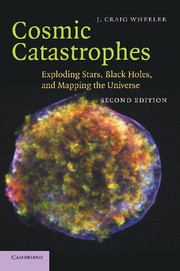Book contents
- Frontmatter
- Contents
- Preface
- 1 Setting the stage: star formation and hydrogen burning in single stars
- 2 Stellar death: the inexorable grip of gravity
- 3 Dancing with stars: binary stellar evolution
- 4 Accretion disks: flat stars
- 5 White dwarfs: quantum dots
- 6 Supernovae: stellar catastrophes
- 7 Supernova 1987A: lessons and enigmas
- 8 Neutron stars: atoms with attitude
- 9 Black holes in theory: into the abyss
- 10 Black holes in fact: exploring the reality
- 11 Gamma-ray bursts, black holes and the Universe: long, long ago and far, far away
- 12 Supernovae and the Universe
- 13 Wormholes and time machines: tunnels in space and time
- 14 Beyond: the frontiers
- Index
2 - Stellar death: the inexorable grip of gravity
Published online by Cambridge University Press: 14 September 2009
- Frontmatter
- Contents
- Preface
- 1 Setting the stage: star formation and hydrogen burning in single stars
- 2 Stellar death: the inexorable grip of gravity
- 3 Dancing with stars: binary stellar evolution
- 4 Accretion disks: flat stars
- 5 White dwarfs: quantum dots
- 6 Supernovae: stellar catastrophes
- 7 Supernova 1987A: lessons and enigmas
- 8 Neutron stars: atoms with attitude
- 9 Black holes in theory: into the abyss
- 10 Black holes in fact: exploring the reality
- 11 Gamma-ray bursts, black holes and the Universe: long, long ago and far, far away
- 12 Supernovae and the Universe
- 13 Wormholes and time machines: tunnels in space and time
- 14 Beyond: the frontiers
- Index
Summary
RED GIANTS
The Sun looks the same to us, unchanging, day after day. A simple observation, however, tells us that it is evolving and must be changing in some manner. That observation is just the warmth on our upturned faces on a sunny day. The radiation that flows from the Sun carries energy out into space. There is nothing from space replacing that energy. The Sun must, therefore, be losing energy overall. Something must be going on within the Sun that is slowly, inevitably altering it. The lesson from Chapter 1 is that the change in the Sun involves its composition. The Sun is irrevocably transmuting some of its hydrogen into helium. That transformation cannot be undone. The alteration of the structure of the Sun is slow, but it is steady. Eventually, the changes will be drastic.
As remarked in Chapter 1, the hydrogen burns only in the center of a star, where the temperatures are highest. That means that the central region is where the hydrogen is consumed and the helium builds up. Even when the hydrogen is fully transformed in the central region, the outer, cooler portions of the star will not have burned. They retain their original composition. This causes the star to become schizoid and to do two things simultaneously: shrink and swell. This development is in strict accord with the principle of conservation of energy, but the application of this principle is more complex than for stars with a homogeneous composition.
- Type
- Chapter
- Information
- Cosmic CatastrophesExploding Stars, Black Holes, and Mapping the Universe, pp. 27 - 41Publisher: Cambridge University PressPrint publication year: 2007



